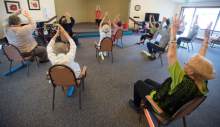This is an archived article that was published on sltrib.com in 2014, and information in the article may be outdated. It is provided only for personal research purposes and may not be reprinted.
Actor Maurice Chevalier famously said that old age isn't bad when you consider the alternative. But a U.S. Census survey released Tuesday confirms that old age can still be rough, showing a third of senior citizens in Utah have a disability.
The exact estimate is 35.8 percent for Utahns age 65 and older, measured between 2008 and 2012. But that percentage of senior disability is better than in most states.
Utah ranks No. 11 among the states, and better than the national average of 38.7 percent. The best among the states is Arizona at 34.6 percent, and the worst is Mississippi at 48 percent.
Some reasons for Utah's better-than-average numbers could include lower rates for smoking and drinking here due to the Mormon influence, and close-knit families and communities that help the elderly receive early treatment when health problems appear.
"I can tell you in talking with centenarians, you probably hear more of them say they live a drug-, alcohol- and smoke-free life — clean living as some might say. But we've had a few, though, who have said the opposite," said Elizabeth Sollis, spokeswoman for the Utah Department of Human Services.
She said while her department does not have specific data that show reasons for Utah's lower rate of seniors with disabilities, it believes they likely include residents' strong commitment to family, community and healthy lifestyles.
For example, she said, "Utah is really good at having support both in the family and in the community. I think with strong support you are more likely to experience early intervention that helps aid and prolong a healthy lifestyle."
She said research on aging has revealed a "village effect," where people who feel they belong to a village or group of people are more likely to avoid physical and mental problems as they age.
"Having interaction with people is huge," she said.
"When people are getting out and being social, whether it's through community activities, religious activities, or family activities — that helps with people's cognitive abilities because they are interacting, so they are having to think and utilize motor skills," Sollis said.
She adds that services for seniors offered by the state have the goal "to try to provide assistance that helps people to maintain self sufficiency and stay in their communities."
The Census study asked in phone interviews if seniors had any of six types of disabilities — problems that make it difficult to walk, live independently, see, hear, provide self-care, or think clearly.
Respondents often reported more than one disability. For example in Utah, 54 percent of those with disabilities reported having more than one. Nationally, that was true with 59 percent of respondents.
Problems with walking was the most common complaint nationally, reported by 66 percent of those with self-identified disabilities.
That was followed by problems affecting the ability to live independently, 48 percent; sight, 40 percent; cognitive skills, 29 percent; self care, 28 percent; and hearing, 19 percent. That adds up to more than 100 percent because of the many people reporting more than one disability.
The study found that education seems to make a difference. More than half of seniors who had not graduated from high school had a disability, twice the rate of those with a bachelor's degree or higher.
Disability rates were also lower for currently married older people than unmarried individuals.
The study also noted that "with the first Baby Boomers having entered the 65-and-older ranks in 2011, the United States may experience a rapid expansion in the number of older people with a disability in the next two decades." —
Seniors age 65 and up with disabilities
Utah (11th best in nation) • 35.8%
U.S. average • 38.7%
Arizona (nation's lowest) • 34.6%
Mississippi (highest) • 48%
Source: U.S. Census



